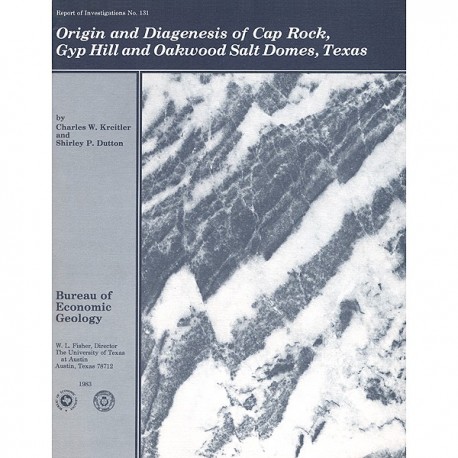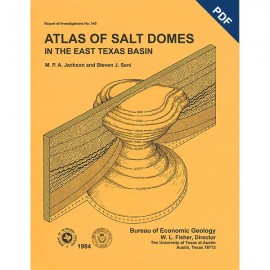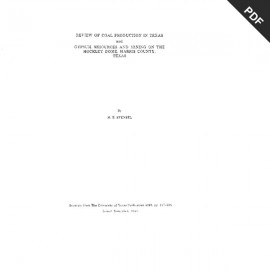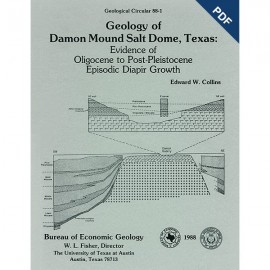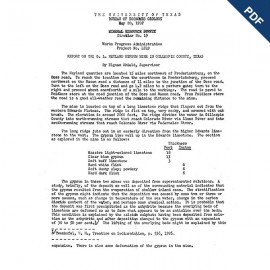Reports of Investigations
-
Books & Reports
- Reports of Investigations
- Guidebooks
- Udden Series
- Geological Circulars
- Down To Earth
- Atlases of Major Oil and Gas Reservoirs
- Texas Memorial Museum Publications
- Environmental Geologic Atlas of the Texas Coastal Zone
- Mineral Resource Circulars
- Other Reports
- Seminars and Workshops
- Handbooks
- Submerged Lands of Texas
- Symposia
- Annual Reports
- Open File Reports
-
Maps & Cross Sections
- Thematic Maps
- Miscellaneous Maps, Charts & Sections
- Geologic Atlas of Texas
- STATEMAP Project Maps
- Geologic Quadrangle Maps
- Cross Sections
- Highway Geology Map
- Energy and Mineral Resource Maps
- Shoreline Change and Other Posters
- Wilcox Group, East Texas, Geological / Hydrological Folios
- Bouguer Gravity Atlas of Texas
- River Basin Regional Studies
- Featured Maps
- Posters
- Teachers & the Public
-
Geological Society Publications
- Gulf Coast Association of Geological Societies
- Alabama Geological Society
- Austin Geological Society
- Corpus Christi Geological Society
- Houston Geological Society
- Lafayette Geological Society
- Mississippi Geological Society
- New Orleans Geological Society
- South Texas Geological Society
- GCS SEPM Publications
- Historic BEG & UT Series
Origin and Diagenesis of Cap Rock, Gyp Hill and Oakwood Salt Domes, Texas. Digital Download
RI0131D
A free, digital version of this publication can be found on: Texas ScholarWorks
To purchase a print version (if available): RI0131
RI0131D. Origin and Diagenesis of Cap Rock, Gyp Hill and Oakwood Salt Domes, Texas, by C. W. Kreitler and S. P. Dutton. 58 p., 52 figs., 9 tables, 1983. doi.org/10.23867/RI0131D. Downloadable PDF.
To purchase this publication in book format, please order RI0131.
ABSTRACT
Petrographic and geochemical studies of caprock core from two salt domes, Gyp Hill in South Texas and Oakwood in East Texas, reveal the significantly different diagenetic histories of each dome. Cap rock on Gyp Hill is now forming within a shallow meteoric aquifer. In contrast, cap rock on Oakwood Dome formed principally during the geologic past within deep, saline aquifers in the East Texas Basin.
Gyp Hill cap rock, which is 890 ft (271 m) thick, is composed of 490 ft (149 m) of anhydrite overlain by 400 ft (122 m) of gypsum. Uncemented anhydrite sandstone marks the salt/cap-rock interface. From 13 ft (4 m) above the interface to the top of the anhydrite, porosity is occluded by poikilotopic gypsum cement. Occurrence of gypsum cement indicates low-temperature, low-salinity conditions during caprock formation; that is, dome dissolution is occurring in a shallow meteoric aquifer. The overlying gypsum results from hydration of anhydrite by meteoric ground water.
Oakwood cap rock, which is 450 ft (137 m) thick, is composed of 256 ft (78 m) of anhydrite overlain by 194 ft (59 m) of calcite. In contrast to Gyp Hill anhydrite, Oakwood anhydrite is entirely devoid of gypsum cement except at the interface between anhydrite and calcite. The anhydrite has been recrystallized into a moderately well developed granoblastic texture that is indicative of high-temperature and high-pressure conditions. Fluid inclusions in the salt at the salt/cap-rock interface represent waters from the last dissolution event. The delta 18O of water from a fluid inclusion is +/-5.4 ppm, indicating a deep-basin origin of the water. The anhydrite section is considered to have accumulated during salt dissolution under deep, high-temperature, saline conditions. Timing of the development of major rim synclines surrounding Oakwood Dome indicates that the anhydrite cap rock formed in Early Cretaceous time. The calcite section of the cap rock is composed of alternating layers of dark and light calcite.
Petrographic, geochemical, and isotopic data on dark calcite indicate that the dark calcite is the product of calcium sulfate reduction by hydrocarbons in a saline, deep-basin fluid. Another deep-basin fluid, more enriched in Sr, Ba, Mg, and Mn, dissolved some of the dark calcite, which then reprecipitated as coarsely crystalline light calcite. The only effect of meteoric water on either the anhydrite or the calcite section of the Oakwood cap rock is the presence of gypsum in the calcite/anhydrite transition zone. Anhydrite cap rock beneath the salt overhang of Oakwood Dome (~6,000 ft deep) had an origin similar to that of the cap rock on top of the dome.
Petrographic analyses of cap rock from Rayburn's and Vacherie Domes (Louisiana) and Cypress Creek and Richton Domes (Mississippi) further substantiate the two different types of cap rock. The cap rock from Rayburn's Dome is similar to that at Gyp Hill Dome, whereas the cap rock from Vacherie is similar to Oakwood Dome cap rock. The mineralogy and textures observed in cap rocks from Richton and CypressCreek Domes indicate that they are intermediate between Gyp Hill and Oakwood cap rocks. Petrographic and geochemical studies of cap rock are important in evaluating the hydrologic stabilities of salt domes being considered as repositories for high-level nuclear wastes. Anhydrite cap rocks such as those at Oakwood Dome contain recrystallized anhydrite, are devoid of gypsum, have a tight cap-rock/salt contact, and formed early in the geologic history of the basin. There is no evidence within the cap rock of recent salt dissolution by meteoric ground water. In contrast, cap rocks such as those at Gyp Hill contain unrecrystallized anhydrite, are cemented with gypsum, and have both uncemented anhydrite sands and a cavity at the salt/cap-rock contact. They also exhibit ample evidence of recent salt dissolution by meteoric water, a condition unacceptable in a salt dome being considered as a high-level nuclear waste repository.
Keywords: cap rock, salt dome, Texas, Gyp Hill, Oakwood Dome
CONTENTS
ABSTRACT
INTRODUCTION
GYP HILL DOME
Salt-stock lithology
Cap-rock lithology
Anhydrite cap rock
Gypsum cap rock
Diagenetic history
OAKWOOD DOME
Salt-stock lithology
Salt! anhydrite interface
Cap-rock lithology
Anhydrite section
Anhydrite/ calcite interface
Calcite section
Chemical analyses
Isotopic analyses
Geochemical trends
Anhydrite zone
Calcite zone
Anhydrite/ calcite interface
Isotopic trends
Calcite zone
Fluid inclusion in salt
Cap-rock diagenesis
Formation of anhydrite zone
Timing of anhydrite cap-rock formation
Formation of the calcite zone
Transition zone
Flank cap rock
Sequence of diagenetic events
PETROGRAPHIC STUDIES OF OTHER DOMES
Rayburn's Dome
Vacherie Dome
Cypress Creek Dome
Richton Dome
Gulf of Mexico salt structure
CAP-ROCK FORMATION: IMPLICATIONS FOR NUCLEAR WASTE ISOLATION
ACKNOWLEDGMENTS
REFERENCES
Figures
1. Schematic diagram of cap-rock formation
2. Location of salt domes with cap rock studied in this report
3. Topographic relief of Gyp Hill salt dome
4. Cross section of Gyp Hill salt dome
5. Anhydrite crystals within Gyp Hill salt stock; depth 915 ft (278.9 m)
6. Cluster of anhydrite crystals, which may be a clast of anhydrite rock in the salt stock; depth 915 ft (278.9 m)
7. Core photographs of Gyp Hill cap rock
8. Graphic core description of Gyp Hill cap rock
9. Porous anhydrite sandstone at base of Gyp Hill cap rock; depth 890 ft (271.3 m)
10. Fine-grained crushed anhydrite between larger anhydrite crystals in Gyp Hill cap rock; depth 890 ft (271.3 m)
11. Poikilotopic gypsum cement filling pore space and replacing anhydrite crystals in Gyp Hill cap rock; depth 837 ft {255.1 m)
12. Percent gypsum versus depth in Gyp Hill cap rock
13. Fine-grained, relatively unstrained gypsum from Gyp Hill cap rock; depth 106 ft (32 m)
14. Highly strained, equigranular gypsum from Gyp Hill cap rock; depth 15 ft (4.6 m)
15. Bladed gypsum crystals from Gyp Hill cap rock; depth 74 ft (22.6 m)
16. Shear fractures in gypsum from Gyp Hill cap rock; depth 308 ft (93.9 m)
17. Strained gypsum, quarry wall, Gyp Hill salt dome
18. Gypsum-anhydrite equilibrium diagram
19. Graphic core description of Oakwood cap rock
20. Core photographs of Oakwood cap rock
21. Geologic cross section of Oakwood salt dome
22. Anhydrite crystals in Oakwood salt stock; depth 1,163 ft (354.5 m)
23. Salt/anhydrite contact at Oakwood salt dome; depth 1,163 ft (354.5 m)
24. Tightly interlocking, xenoblastic crystals in anhydrite section of Oakwood cap rock; depth 1,160 ft (353.6 m)
25. Contact between coarse· and fine-grained anhydrite layers in Oakwood cap rock; depth 1,086 ft (331.0 m)
26. Fracture in Oakwood anhydrite cap rock with smooth, slickensided surface
27. Calcite cement corroding anhydrite near the top of the Oakwood anhydrite cap rock; depth 926 ft (282.2 m)
28. Network of fine-grained dark calcite and pyrite surrounding large pores in the Oakwood anhydrite-calcite transition zone; depth 907 ft (276.5 m)
29. Poikilotopic gypsum cement and anhydrite in anhydrite-calcite transition zone, Oakwood cap rock; depth 906 ft (276.1 m)
30. Fibrous gypsum and fine-grained calcite in anhydrite-calcite transition zone, Oakwood cap rock; depth 907 ft {276.5 m)
31. Coarsely crystalline secondary calcite that grew into open pore space in calcite section of Oakwood cap rock; depth 757 ft {230. 7 m)
32. Coarse calcite under cathodoluminescence, showing multiple growth zones
33. Strontium versus CaS04 in salt, Oakwood salt dome
34. Concentrations of Na, Cl, Fe, and Al in light and dark calcite, Oakwood Dome
35. Concentrations of Mg, Sr, and Mn in light and dark calcite, Oakwood Dome
36. Gas-liquid chromatographic traces of light and dark calcite from Oakwood Dome, Brazoria County, of biodegraded hydrocarbons, Damon Mound, and unaltered crude oil,Brazoria County, Texas
37. The δ13C (relative to PDB standard) of calcites versus depth in Oakwood cap rock
38. The δ18O (relative to PDB standard) of calcites versus depth in Oakwood cap rock
39. The δ18O trend of calcite versus depth and temperature, Frio Formation, Texas Gulf Coast
40. Anhydrite and calcite beneath overhang of Oakwood salt dome, based on electric log responses
41. Cap rock sample from the flank of Oakwood Dome overhang
42. Anhydrite from Oakwood Dome overhang showing strong preferred orientation of crystals
43. Patches of fibrous gypsum in porous anhydrite sandstone, Rayburn's Dome cap rock; depth 108 ft (32.9 m)
44. Poikilotopic gypsum cement surrounding anhydrite crystals in Rayburn's Dome cap rock; depth 102 ft (31 m)
45. Fine-grained gypsum from Rayburn's Dome cap rock; depth 77 ft (23.5 m)
46. Tightly interlocking xenoblastic crystals of anhydrite in Vacherie Dome cap rock; depth 750 ft (228.6 m)
47. Contact between coarse- and fine-grained anhydrite layers in Vacherie Dome cap rock; depth 588 ft (179.2 m)
48. Sharp contact between salt and anhydrite cap rock at Cypress Creek Dome; depth 1,386 ft {422.5 m)
49. Gypsum-filled fracture within anhydrite cap rock at Richton Dome
50. Recrystallized anhydrite in Richton cap rock; depth 634 ft (193.2 m)
51. Partially dissolved anhydrite crystals from a Gulf of Mexico salt structure, well 114-A
52. Halite-cemented anhydrite from a Gulf of Mexico salt structure, well 114-A
Tables
1. Porosity and permeability of Gyp Hill cap rock
2. Porosity and permeability of Oakwood cap rock
3. Chemical analyses of cap rock, Oakwood salt dome
4. Gross C15 composition of biodegraded crude oil samples from light and dark calcites, Oakwood salt dome, compared to similar samples from Damon Mound salt dome and non-biodegraded oil from Brazoria County, Texas
5. Elemental concentrations in porous calcite from calcite/ anhydrite transition (sample 905.5 PD)
6. Carbon and oxygen isotopic values, calcite zone, Oakwood salt dome
7. Volume of salt dissolved from Oakwood Dome to form its cap rock
8. Timing and volumes of rim synclines surrounding Oakwood Dome
9. Volume loss from conversion of anhydrite to calcite
Citation
Kreitler, C. W., and Dutton, S. P., 1983, Origin and Diagenesis of Cap Rock, Gyp Hill and Oakwood Salt Domes, Texas: The University of Texas at Austin, Bureau of Economic Geology, Report of Investigations No. 131, 58 p.
